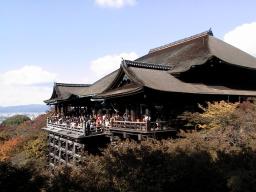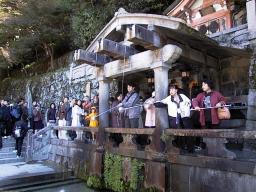

I had initially planned to finish my extensive temple tour at Ginkakuji (Silver Pavilion, note the one letter difference to Kinkakuji alias Golden Pavilion on the western side) but didn't have time for that. Nevertheless, I walked through the park up to the entrance following a path called "Philosopher's walk".
At night there were again some sites with special illumination. However, I decided that I'd had my share of temples for the day and set the course towards amusement centers in the city center instead. All Japanese cities of even moderate size have halls with dozens of different coin-operated machines to satisfy game enthusiasts. Perhaps the most peculiar type from Western point of view is Pachinko: the player feeds small metal balls into a machine with various flashing and moving parts and just watches how the balls bounce around.

|
Tuesday morning I met Nicolas (from Australia) and Marie-Anne (Irish) and we decided to spend the day together. The picture is from Nijo castle (二条城)which featured a vast garden and big halls, mostly empty though. One interesting detail found in both Nijo and some temples was the "Nightingale" floor in the hallways. The supports under the wooden planks were constructed to give a squeaking sound when stepping on them, thus warning about possible enemies trying to sneak in. |
|
Nicolas and Marie-Anne continued towards Kinkakuji and as I had already been there I wanted to do something else. Nicolas had the Lonely Planet guide which described a short hike in the Arashiyama (嵐山)area. That sounded nice so I made notes and took a bus there. Upon arrival, I was a bit puzzled - there was the river mentioned in the guide but no hiking path. Only later did I realize that I had missed one critical part when writing my notes - I shouldn't have taken the bus to the Arashiyama stop but instead to a place called Takao a few kilometers north. The hike was supposed to end around the place where I was. It was already too late to do the walk in the other direction but I had still time to go a little bit upstream and come back. Based on that part I can already recommend the area if you are in Kyoto and want to see something else than temples, shrines and villas for one day or at least a few hours. Tuesday obviously wasn't my best day: when going back to Kyoto station I first took a bus in wrong direction (line 28 makes a weird detour - even though Kyoto station is south-east from Arashiyama one must take the bus towards the west!) and the second one was stuck in a traffic jam. Fortunately I had initially reserved plenty of time and got to the Kyoto station at the last minute to catch the bus back to rainy Kanazawa. Friends told me that it had been raining whole weekend so apparently it was perfect timing to visit Kyoto. Didn't have enough time to see everything, so I'll surely go there another time while living in Kanazawa, only a few hours away. |
|
|
Copyright Arto Teräs <ajt@iki.fi> 2002. Redistribution of this document as a whole or any of the pictures individually is permitted in any medium provided this copyright notice is preserved. Last update 20.12.2002. |
|